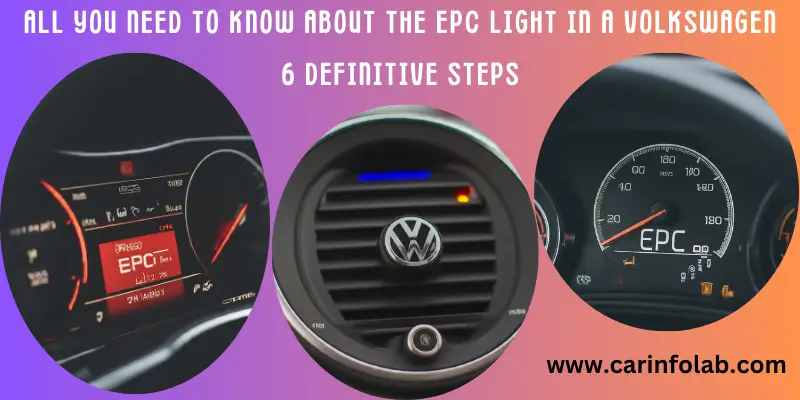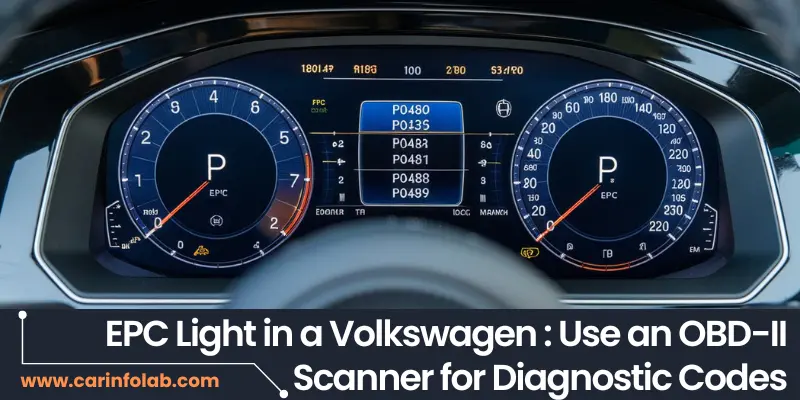All You Need to Know About the EPC Light in a Volkswagen – 6 Definitive Steps
Updated: September 15, 2024
142
The EPC (Electronic Power Control) light is a common warning indicator in Volkswagen vehicles. It may seem alarming when this light appears, but understanding its purpose and how to address it can save you from stress. It may cause the reasons a car loses all electrical power. In this article, we’ll walk you through everything you need to know about the EPC light in a Volkswagen, why it shows up, and what steps you can take to fix it.
What Does the EPC Light Mean?
The EPC light in a Volkswagen is tied to the car’s electronic control system, which manages various functions like throttle, cruise control, and the ignition system. When the EPC light comes on, it means that there’s an issue somewhere in this system.
Some reasons behind the EPC light include:
- Faulty sensors
- Throttle problems
- Brake light switch failure
- Ignition system issues
- Wiring issues
The light acts as a warning to let you know that something needs attention. Although the issue might not seem urgent at first, ignoring it can lead to bigger problems down the line.

6 Definitive Steps to Address the EPC Light in Your Volkswagen
If you notice the EPC light on your dashboard, don’t panic. Follow these six steps to address and resolve the issue.
1. Stop Driving and Assess the Situation
When the EPC light appears on your dashboard, it’s important to stop driving and evaluate the situation. Here’s a helpful table to guide you through the process:
| Situation | What to Check | Action |
|---|---|---|
| Car Performance Issues | – Is the car losing power? – Are there unusual noises? – Is the throttle unresponsive? | If you notice any of these issues, pull over safely. |
| Throttle Response | – Is the throttle pedal feeling different? – Is it not responding as usual? | If the throttle is not working properly, avoid accelerating aggressively. |
| Warning Lights | – Is the EPC light the only light on? – Are there other warning lights present? | Note if other lights are also on, as this might indicate additional problems. |
What to Do Next:
| Tips |
|---|
|
2. Turn the Engine Off and Restart
Sometimes, turning off the engine and restarting it can resolve minor issues that trigger the EPC light. Here’s a straightforward guide to help you through this process:
| Step | What to Do | Why It Helps |
|---|---|---|
| 1. Pull Over Safely | Find a safe spot to park your vehicle. | Ensures you are out of harm’s way. |
| 2. Turn Off the Engine | Completely shut down the engine. | This can reset the vehicle’s electronics. |
| 3. Wait a Few Minutes | Allow the vehicle to sit for about 1-2 minutes. | Gives the system time to reset. |
| 4. Restart the Engine | Start the engine as you normally would. | Check if the EPC light goes off. |
Tips:
| Tips |
|---|
|
3. Check the Brake Lights
One common cause of the EPC light coming on in your Volkswagen is a malfunctioning brake light switch. The brake light switch is crucial for the EPC system, as it signals the car’s electronic control module when the brake pedal is pressed. Don’t ignore the rcta light in the car.
Here’s a guide to help you check the brake lights and resolve any issues:
| Step | What to Do | Why It Helps |
|---|---|---|
| 1. Turn On the Car | Start your vehicle and turn on the ignition. | Necessary to check the brake lights. |
| 2. Press the Brake Pedal | Firmly press the brake pedal. | Activates the brake lights for inspection. |
| 3. Check the Brake Lights | Have someone stand behind the car or use a reflective surface. | Ensure the brake lights are functioning properly. |
| 4. Inspect for Issues | Look for any issues such as dim lights or lights not turning on. | Identifies problems with the brake light system. |
| 5. Replace the Brake Light Switch | If the brake lights are not working, consider replacing the brake light switch. | A faulty switch could be the cause of the EPC light. |
| 6. Test the Lights Again | After replacing the switch, test the brake lights once more. | Confirms that the issue has been resolved. |
Tips:
| Tips |
|---|
|
Common Brake Light Problems:
| Problem | Possible Cause | Solution |
|---|---|---|
| Brake Lights Not Working | Faulty brake light switch or blown bulbs. | Replace the brake light switch or bulbs. |
| Dim Brake Lights | Poor electrical connection or faulty bulbs. | Check connections and replace bulbs if needed. |
| Brake Lights Stay On | Stuck brake light switch. | Adjust or replace the brake light switch. |
4. Check the Throttle Body
The throttle body plays an important role in controlling the air intake in the engine. If the EPC light appears, it may signal an issue with the throttle. You can check the throttle body by:
- Looking for dirt or debris that could block airflow.
- Make sure the throttle body is clean.
If the throttle body is dirty or malfunctioning, cleaning or replacing it could solve the problem.
“The EPC light is a key indicator of your car’s health. Regular maintenance and quick responses to warning lights like EPC can save you from more significant troubles down the road.”Volkswagen Specialist, Michael Brown
5. Use an OBD-II Scanner for Diagnostic Codes
An OBD-II (On-Board Diagnostics) scanner is a useful tool for diagnosing issues when the EPC light is on. It reads error codes from your vehicle’s computer, helping to pinpoint the problem.
| Step | What to Do | Why It Helps |
|---|---|---|
| 1. Locate the OBD-II Port | Find the OBD-II port, usually under the dashboard near the steering wheel. | The scanner connects to this port to read codes. |
| 2. Connect the Scanner | Plug the OBD-II scanner into the port. | Ensures the scanner can communicate with the car’s computer. |
| 3. Turn On the Ignition | Switch the ignition to the “On” position without starting the engine. | Powers up the vehicle’s computer system. |
| 4. Read the Codes | Follow the scanner’s instructions to retrieve error codes. | Identifies specific issues that triggered the EPC light. |
| 5. Interpret the Codes | Refer to the scanner’s manual or look up the codes online. | Helps you understand what the codes mean and what parts might be affected. |
Additional Tips:
| Tips |
|---|
|

Common OBD-II Codes Related to EPC Light:
| Code | Description |
|---|---|
| P0120 | Throttle/Pedal Position Sensor A Circuit Malfunction |
| P0220 | Throttle/Pedal Position Sensor B Circuit Malfunction |
| P0325 | Knock Sensor Circuit Malfunction |
| P0420 | Catalyst System Efficiency Below Threshold |
Using an OBD-II scanner helps you get to the root of the problem quickly and accurately, making it easier to address the issue and keep your Volkswagen running smoothly.
6. Visit a Certified Mechanic
If you’ve tried the above steps and the EPC light remains on, it’s time to visit a certified Volkswagen mechanic. Ignoring the EPC light can lead to further damage, so it’s essential to have a professional inspect and repair the issue.
Conclusion
The EPC light in your Volkswagen might seem like a small issue, but it’s important to address it quickly. Ignoring the light can lead to further problems with your car’s performance and safety. By following the six steps outlined in this guide, you can troubleshoot the issue and determine whether it requires professional assistance. Regular maintenance and attention to your car’s electronic systems and focus on faulty valve cover gasket symptoms can help prevent future problems and keep your Volkswagen running smoothly.
FAQs
What should I do if the EPC light comes on while driving?
If the EPC light appears while you’re driving, pull over when it’s safe and restart the engine. If the light stays on, it’s best to visit a mechanic to prevent further issues.
Is it safe to drive with the EPC light on?
While you may be able to drive with the EPC light on, it’s not recommended. The light could indicate a serious issue that could affect the car’s performance or safety.
Can I fix the EPC light issue myself?
Some issues, like a faulty brake pedal switch, are simple to fix. However, more complex problems, such as those involving the throttle or ignition system, may require professional assistance.
Will an OBD-II scanner tell me the exact problem?
Yes, using an OBD-II scanner will give you error codes that point to the issue. These codes can help you identify the problem and decide whether you can fix it yourself or need to see a mechanic.
Please Write Your Comments